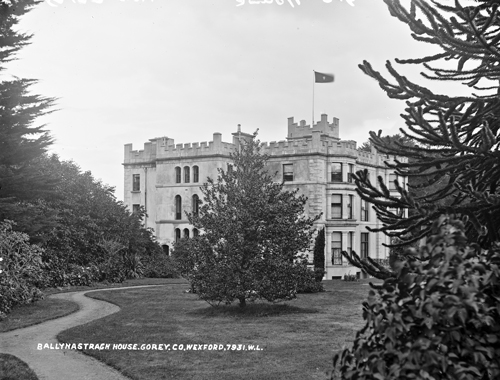Wexford Mansion of Free State Senator destroyed by fire
Gorey,12 March 1923 - The beautiful Co. Wexford mansion owned by Senator Sir Thomas Esmonde was destroyed by fire on the 9th of March. Its destruction was deliberate. A force of approximately fifty raiders entered the magnificent house at night through one of its lower windows.
The Senator was not in residence at the time of the attack as he left for London a month ago on business in the company of his daughter. However, his brother, Col. Esmonde, formerly of the Royal Dublin Fusiliers, was present at the time, as were five servants. All six of them were given ten minutes to get ready, after which they were taken to an outbuilding under armed guard.
The mansion was set alight using petrol poured over furniture and through the many rooms. Gas bombs were also used, the huge flames emitted were visible for miles around, attracting amongst others, National Army troops at nearby Gorey. By the time they arrived at the scene, however, the raiding party had left.
Ballynastragh House, with about forty rooms and a distinctive, imposing tower, has been a well-known local landmark since its construction close to 400 years ago.
Remodelled about 1870 by Sir Thomas Esmonde’s father, Col. John Esmonde, the house contained much antique furniture and one of the country’s most extensive libraries, all of which has now been lost. The library housed many historical documents dating from 1600, including some dealing with the Jacobite period, the 1798 rebellion, and the era of Daniel O’Connell. Letters from Charles Steward Parnell were also kept in the library, all now incinerated.
Mercifully, however, Sir Thomas had removed some rare pictures and hunting trophies from the property some time ago. Expected to return to Dublin today, Sir Thomas told a Press Association representation in London that he learned via a wire that his house had been burned down. ‘The only reason for such an act so far as I know is that I am a Senator of the Free State, and, of course, I am in no worse a position than anybody else.’
According to Esmonde, the house had been first built in 1300, the original building being burned down during the campaigns of Oliver Cromwell. The remodelled mansion has suffered a similar fate and the famous Wexford landmark has now been reduced to a walled shell.
[Editor's note: This is an article from Century Ireland, a fortnightly online newspaper, written from the perspective of a journalist 100 years ago, based on news reports of the time.]





















